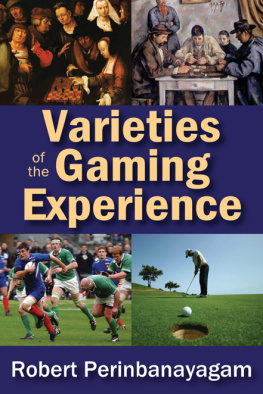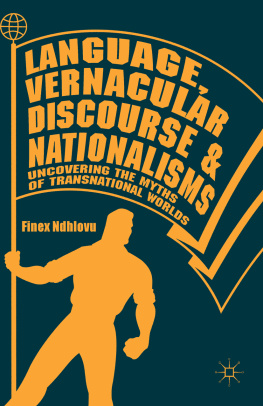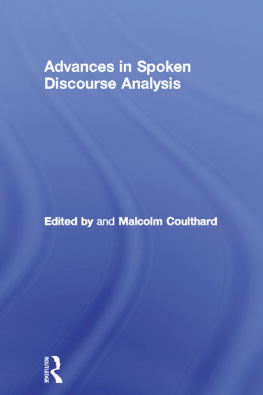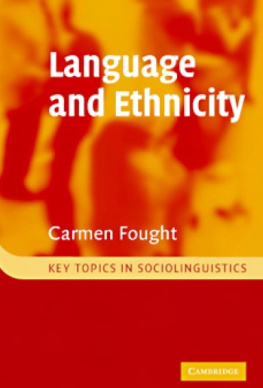Originally published in 1991 by Transaction Publishers
Published 2011 by Transaction Publishers
Published 2017 by Routledge
2 Park Square, Milton Park, Abingdon, Oxon OX14 4RN
711 Third Avenue, New York, NY 10017, USA
Routledge is an imprint of the Taylor & Francis Group, an informa business
New material this edition copyright 2011 by Taylor & Francis.
All rights reserved. No part of this book may be reprinted or reproduced or utilised in any form or by any electronic, mechanical, or other means, now known or hereafter invented, including photocopying and recording, or in any information storage or retrieval system, without permission in writing from the publishers.
Notice:
Product or corporate names may be trademarks or registered trademarks, and are used only for identification and explanation without intent to infringe.
Library of Congress Catalog Number: 2010005529
Library of Congress Cataloging-in-Publication Data
Perinbanayagam, R. S., 1934
Discursive acts : language, signs, and selves / Robert S. Perinbanayagam.
p. cm
Rev. and updated ed. of: Discursive acts. c1991.
Includes bibliographical references and index.
ISBN 978-0-202-36353-0 (alk. paper)
1. Discourse analysis. 2. Dialogue. 3. Conversation. I. Perinbanayagam, R. S., 1934- Discursive acts. II. Title.
P302.P445 2010
401.41--dc22
2010005529
ISBN 13: 978-0-202-36353-0 (pbk)
To the many in the University of Minnesota in the early sixties, both colleagues and teachers, who, with their various acts of kindness and consideration, made my life there both intellectually stimulating and emotionally fulfilling.
Language enters life through concrete utterances (which manifest language) and life enters language through concrete utterances as well.
Mikhail Bakhtin
This volume is a revised version of my earlier work, Discursive Acts. Various sections of the work have been overhauled systematically, new sections added in place of others, and some infelicities and obscurities, I hope, have been removed. In truth I set out to make some slight changes in the book and have it republished, but the more I got into it the more convinced I became that a major overhaul was needed. The result is almost a new work
In the following pages I attempt to relate various recent theories of language and discourse to earlier theories of signs and selves to produce a description of the structures and processes of conversations in everyday life and their consequences to the human agent. These conversations constitute the procedures by which selves are given shape and substance. Conversations lead to the emergence of selves, and selves in turn create conversations. In and through reciprocal conversations, two selves reveal what each wants to be taken as: together they not only find each other, but themselves as well.
In analyzing conversations I have sought to use the strengths and insights of various classical and contemporary theorists rather than dwelling at length on their limitations and weaknesses. In the Tamil poem Naladiyar (verse: 135), I have read of a mythical bird that, if it is offered milk mixed with dross in a cup, will be able selectively to drink the milk and leave the rest behind. The poet argues that people of learning should be able to do the same: separate the milk of knowledge from the dross. The poem goes this way:
Knowledge has no boundaries
The days for those who study are but few
Hence do learn with discernment that which is befitting,
Like the bird that drinks the milk separating the dross from it
This, of course, will create another hermeneutic problem, as Norman Denzin has pointed out, because what one interpreter considers milk may be anothers drosseven poison! Nevertheless, this approach can be very useful in dealing with social theory because there is no theory about human agents, insofar as it is produced by other agents, that will not prove to be erroneous on some points and correct on others. Therefore, I have used a number of them in developing my own synthetic theory of signifying acts constructed by the management and control of language, and tried to delineate the various consequences thereof. This has led me to a notion of discourse as an interactional act capable of containing multiple significations, all of them delineating a self and an other in varying forms of dialogues and relationships. Instead of considering the differences between the various relevant schools of thought, I have sought to think of the various ways in which signs, symbols, codes, discourses, grammar, sounds and logic are put to use in the everyday life of human agents.
The theories of language and meaning I have used have been subject to vigorous critiques in recent years. The work of the structuralists has been subject to a particularly sustained attack, as some of structuralisms early advocates have withdrawn their support, or produced their own aufhebung in deconstructionism. Nevertheless, it seems to me that the essential points of the structuralist claims are irrefutable, because the discursive strategies that even the most determined critics use in their own texts reveal the presence of all the structuralist categories! Like Monsieur Jourdain in Molieres play, they will find that not only are they producing prose but a prose that is subject to structuralist formality. Of course, there is a great deal in structuralism that needs to be challenged and replaced. But for all that, as an analytic description of the human symbolic product it has its strengths, particularly when supplemented by the thought of those who came after it and who stood on its shoulders. In any case, theories should not be treated as commodities demanding fetishistic loyalties or as religions demanding devotion but as incomplete programs forever demanding critique and development.
In many ways the work presented here parallels that of work done under other rubricssociolinguistics, conversation analysis, discourse analysis, and ethnomethodology. This work, however, is not an attempt to supersede that done under the influence of these other perspectives, but presents the same matter from a different standpoint. That is to say, ethnomethodology and sociolinguistics focus on certain formal properties of conversations, and they have pursued the quest for these properties with great methodological rigor, while eschewing questions about intentions attitudes and emotions. In their work, as in that of many structuralists, discourse has become depersonalized, with the linguistic form itself becoming an autonomous entity hermetically sealed from the world of selves, and their loves and passions, their angers and hatreds, their conflicts and sufferings. My own interest is in displaying the dialogic properties of such discourses, conceiving each element in them as pragmatic and directed. The dialogue that results from the artful management of discursive acts intertwines various selves and constitutes moments in the career of these selves. Nevertheless, I have benefited from the work of these scholars, undoubtedly harvested, like tea, with delicate hands and I recognize that it was they who opened the field for inquiry and pointed the way for others. Tea however needs to be processed in several stages after being picked to eventually become a good brew!
In this work, G.H. Meads work on conversations as social acts becomes a starting point, followed by Mikhail Bakhtins theories of dialogues and speech genres. The work of many linguists on grammar and many literary theories on style and form, too, become resources for my theory of discursive acts. From Meads work I derive the idea of







